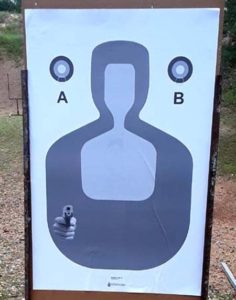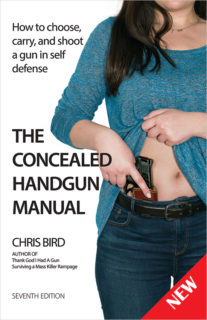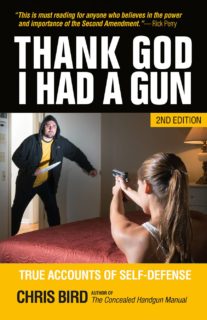Stepping to the Side While Drawing
Some firearms instructors teach people to step to one side while drawing their guns. Others teach that the first shot or two should be from a standing still position because the attacker is likely to miss. I wanted to find out whether stepping to one side or the other made for a slower draw.
So Mike Arnold, Rudy Salazar and I decided to use a timer to put it to the test. We are all in our 70s so we are probably not as fast or accurate as we were when we were young and good looking.
We used the illustrated target at a range of 15 feet. We each drew and fired one shot from concealed standing still. We did this 10 times. Then we did 10 shots while stepping to the left, then 10 stepping off to the right. We each fired 30 rounds in total, all starting with the gun concealed.
Arnold was shooting a full-size SIG P320 from an inside the waistband holster on his right hip. Salazar shot a SIG P938 from an appendix draw holster. He is left handed. I was shooting my CZ 75 Compact from a right-hip belt holster. We timed the shooting with a Pocket Pro timer from Competition Electronics set to a random-delay start.
Salazar was the first to shoot. His first stage was to draw at the beep and fire one shot at the upper chest area of the figure target. The times are in seconds. Those marked with an X missed the light grey area but hit the dark area of the target.
|
|
||||||||||||||||||||||||||||||||||||||||||||||||||||||||||||||||||||||||||||||||||||||||||||||||||||||||||||||||
|

First String Second String Average |
||||||||||||||||||||||||||||||||||||||||||||||||||||||||||||||||||||||||||||||||||||||||||||||||||||||||||||||||
I then shot two strings of five shots each as fast as I could keep the hits in the light grey area to see what my split times were between shots. The times were between the first and second shots, second and third, etc.
Conclusions: I think we all expected to make better times when standing still but such was not the case. The standing still times for Salazar and me were virtually the same as stepping to left or right. Arnold was a little slower stepping to the right, taking an average of 0.14 seconds longer. Given my split times of 0.28 seconds, we would not have faced an extra round of incoming fire by stepping to one side or the other.
Other factors can be considered in deciding whether to step off the line or not. The number of misses in the average gun fight can be a factor. Bill Davison of Tac Pro Shooting Center says even police officers tend to miss about 80 percent of the time so by stepping off line you may be stepping into your assailant’s stream of bullets.
John Farnam of Defense Training International recommends stepping off the line as you draw. In his book, The Farnam Method of Defensive Handgunning, second edition, he states: “You must move and draw simultaneously, so that, by the time your pistol is at eye level and ready to fire, your body is no longer where it was when you started.”
Dean Thompson, an instructor at Tac Pro Shooting Center and former SWAT team member in the Dallas Fort Worth Airport Police, has a problem with always doing any one thing in a confrontation.
“When you make a hard and fast rule of always do this, always do that, it doesn’t work out sometimes because you can’t control the environment at all times,” he says. “The fight may not happen when you expect it or when you want it to. It could be at any time, and at any location.”
Thompson says the situation dictates what you do. So practice different options.




